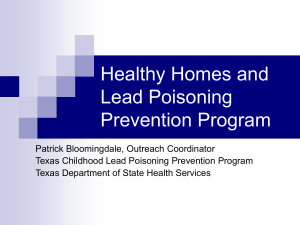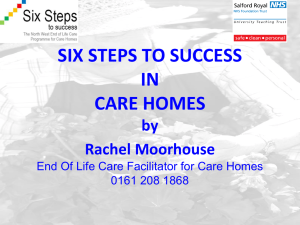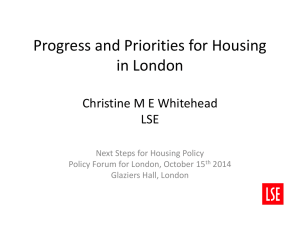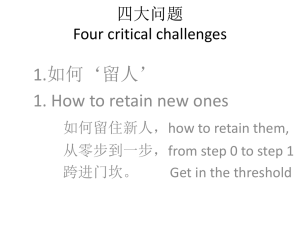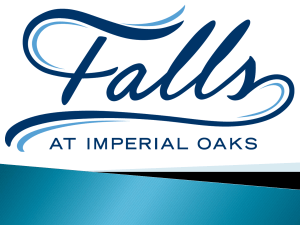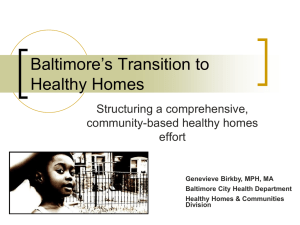CDC Transition Guidance - National Center for Healthy Housing
advertisement
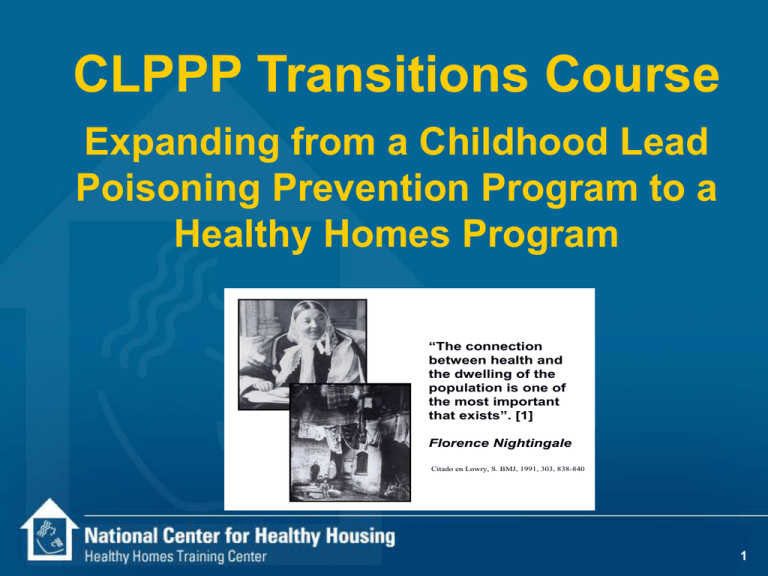
CLPPP Transitions Course Expanding from a Childhood Lead Poisoning Prevention Program to a Healthy Homes Program “The connection between health and the dwelling of the population is one of the most important that exists”. [1] Florence Nightingale Citado en Lowry, S. BMJ, 1991, 303, 838-840 1 Health problems related to housing conditions Asthma Allergies Brain damage Behavior & learning problems Lung cancer Injuries Poisonings 2 Context for a Healthy Homes Program Part of Goal 2 of Healthy People 2020 (a national health agenda) Part of Healthy People 2020 Environmental Health Objectives Surgeon General’s Call to Action to Promote Healthy Homes Presidential Executive Order 12898 for Environmental Justice CDC’s Healthy Homes Initiative 3 Conducting a Needs Assessment First step in developing a Healthy Homes Program. The needs assessment should address: — Community analysis — Training and education — Policy — Program experience — Partnerships — Program evaluation — Surveillance Strategic Plan 4 Community Analysis What are the community demographics? What are the health issues in the community? What are the housing needs in the community? 5 Training and Education Healthy Homes Training Center courses: Essentials for Healthy Homes Practitioners Launching a Healthy Homes Initiative Pediatric Environmental Home Assessment (on-line training) Healthy Homes for Community Health Workers Integrated Pest Management in Multi-family Housing Code Inspection for Healthy Homes Go to www.healthyhomestraining.org 6 Training and Education (continued) CDC Healthy Homes/Lead Poisoning Prevention Training Center – 4 tracks: Program Management Data Management and Surveillance Case Management Primary Prevention 7 Policy Identify strengths and gaps in: State and local laws Regulations Ordinances Program enforcement policies Identify local housing codes and who enforces them Develop an approach to address gaps 8 Program Experience Assess organizational capacity: • Agency resources • Past performance • Infrastructure • Management • Knowledge/skills of staff pertaining to Healthy Homes Don’t forget the Healthy Homes Specialist Credential 9 Partnerships Identify partners who can help address healthy homes issues: • Housing programs • Public health programs • Faith-based and community organizations • Environmental justice and academic centers • Local, state and federal governments • Youth centers • Universities • Fire departments • Advocacy groups • Others 10 Referral Process Develop plan to identify, address and resolve housing issues. Sample flowchart to describe referral process: Home visiting Pgm./ HH Inspectors Reassess Issue Identify issue Program addresses No Partner addresses Issue Resolved? Yes Document in HH database Permanent 11 Program Evaluation Evaluation should answer two questions: 1. Are program activities being implemented and functioning as planned? (process evaluation) 2. Are program activities having the intended effect? (outcome/impact evaluation) Suggested approaches to evaluation: — Four standards of utility, feasibility, propriety and accuracy — Using SMART objectives (specific, measurable, achievable, relevant and time bound) — Logic model 12 Surveillance May need to modify existing surveillance systems or develop new ones to include healthy homes issues. CDC has developed a new web-based Healthy Housing and Lead Poisoning Surveillance System (HHLPSS) that is available Contact your CDC project officer for more information on how to obtain or transition to HHLPSS 13 Strategic Plan Should address four primary questions: Who is the target audience for the intervention? What are the HH constraints of the target audience for the intervention? How will the identified HH needs/constraints be addressed? What are the expected outcomes? 14 Best Practices - Programs should focus on interventions with proven efficacy. - Here is a sample of Interventions where there is “sufficient evidence” to indicate efficacy in improving health: Multi-faceted tailored asthma interventions Integrated Pest Management (pest/allergen reduction) Moisture intrusion elimination Radon air mitigation through active sub slab depressurization Smoking bans 15 Best Practices (continued) - Programs should focus on interventions with proven efficacy. - Here is a sample of Interventions where there is “sufficient evidence” to indicate efficacy in improving health: Smoke Detectors Lead hazard control Installation of working smoking alarms Pre-set safe temperature hot water heaters Housing Choice rental voucher program 16



